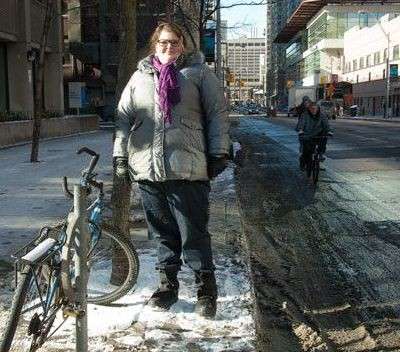Landmark study finds separated bike lanes, slower vehicle speeds greatly reduce bicycle injuries

Using your bicycle to commute to work has numerous health and environmental benefits. Yet, the largest Canadian study on cycling injuries led by Ryerson University suggests cyclists are at risk of injury due to the lack of cycling infrastructure in large urban centres.
"Previous studies have focused on the measures such as helmets that reduce harm after a crash occurs," says Anne Harris, lead author of the study, who is an avid cyclist herself and an assistant professor with Ryerson's School of Occupational and Public Health. "Our study is one of the first to take a comprehensive look at how route infrastructure, particularly at intersections and major roadways, might influence the risk of cyclist injury in Canada."
North American cyclists are eight to 30 more times likely to be seriously injured while cycling than their counterparts in Germany, Denmark and The Netherlands. Harris says one explanation could be the availability of segregated bike lanes in those countries.
The major findings of the Ryerson's School of Occupational and Public Health study are:
Intersections—safer
- Intersections at residential streets
- Cars travelling 30 km and under decreases the risk of injuring a cyclist by half
Intersections—less safe
- Traffic circles: designed as a traffic calming measure, actually increase the risk of cyclist injuries. In the study, 19 out of 690 accidents occurred in Vancouver intersections with traffic circles
- Grade: roads that slope downhill are more dangerous than uphill roads
- Arriving at the intersection in the opposite direction of vehicular traffic
- Separated bike lanes along major streets
- Bike routes with traffic diversion on local streets
- Bike-only paths separated from traffic
- Streetcar tracks
- Downhill grade
- Construction at site
- Shared bike lanes or single bike lanes with parked cars present
"Our research demonstrates that transportation planners really need to segregate cyclists from motor vehicle traffic just as we use sidewalks to separate pedestrians," says Harris. "If people see cycling as a safer activity, they would be more encouraged to commute by bike, which makes them more active and healthy citizens."
Research methodology
Harris and her co-authors, also cyclists, interviewed 690 cyclists injured in downtown Toronto and Vancouver between May 2008 and November 2009. According to Census data, nearly two per cent of people in Toronto and almost four percent in Vancouver commute by bicycle.
In the study, all of the cyclists sought medical attention at emergency departments with injuries ranging from minor to serious. Of the total number of cyclists, 211 were injured at intersections and 479 injured along roads or paths.
The researchers gathered two sets of data. First, they asked all of the cyclists to map the route they were injured on, and describe the details of their trip and their injury. Next, an observer visited one or two randomly selected locations along each route to coincide the injury site (if it was at an intersection or not). Specific details about each site were gathered such as the presence and type of bike lanes, grade of the road and traffic volume. Finally, the researchers performed statistical analyses to look at the relationship between route infrastructure and relative safety.
At the time of the study, both Toronto and Vancouver had cycling infrastructure typical of North American cities: shared bike lanes, local street bike paths, off-street paths and a few kilometres of physically separated bicycle routes beside major roads. Some of the features unique to Toronto were streetcar tracks on major streets, whereas traffic circles are common in Vancouver residential areas. Vancouver also has a helmet law for all ages, where it's optional for Toronto adult cyclists.
The study is published in the journal Injury Prevention.
More information: injuryprevention.bmj.com/conte … 040561.full.pdf+html
Journal information: Injury Prevention
Provided by Ryerson University

















